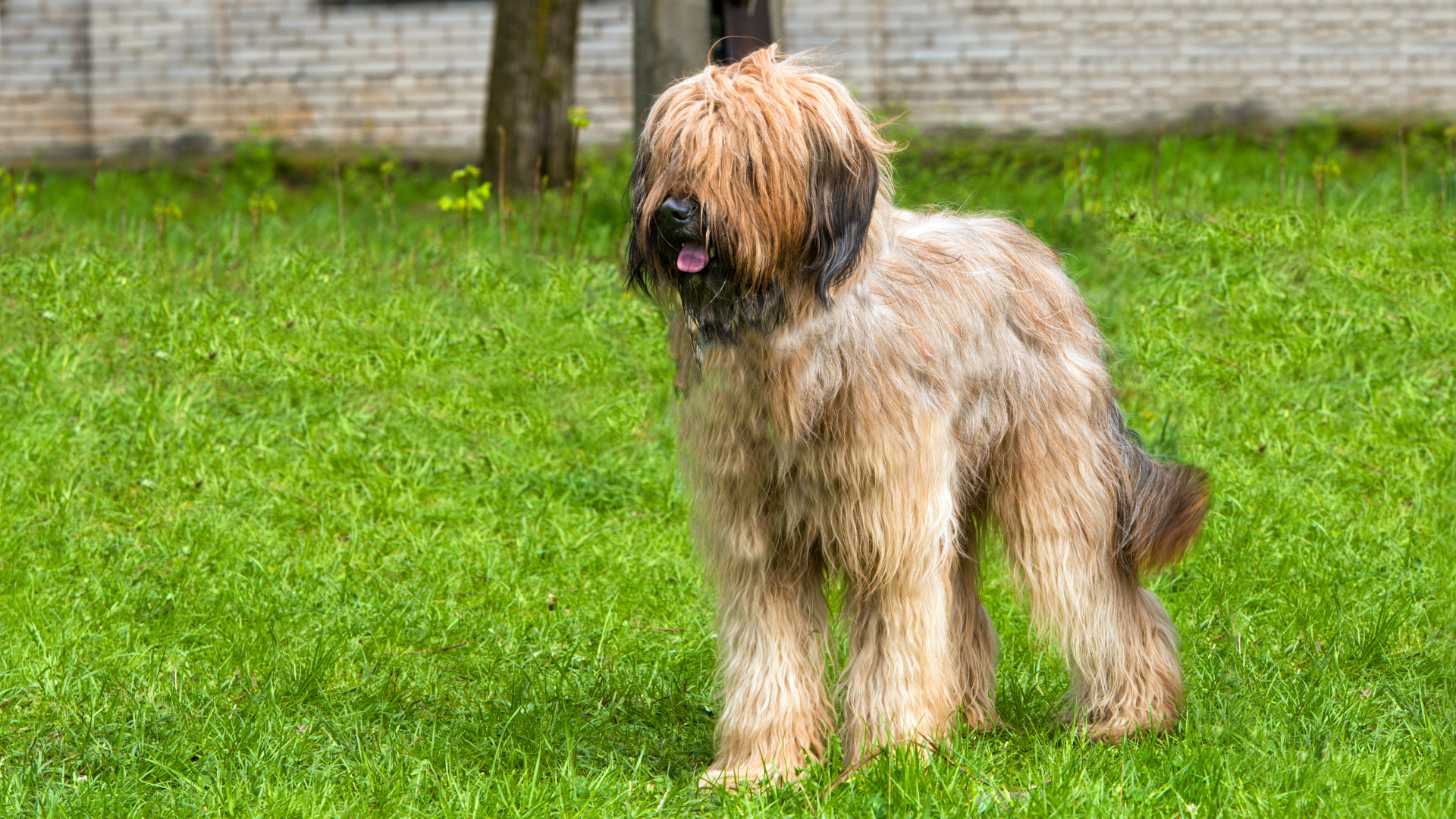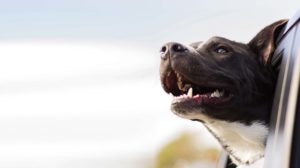Briard | Breed highlights
| Breed: | Hailing from the dairy farming region of Brie in France, he Briard being the official dog of the French army serving as sentry dogs and messengers. Today they are loyal and trainable family dogs |
| Coat type: | Briards have a long, thick double coat that is prone to matting, who need regular brushing and occasional trimming is necessary. |
| Grooming: | The coat naturally repels dirt, so they generally don’t require bathing more than once a month. |
| Activity level: | Briards are an active breed and require regular exercise to keep them physically and mentally stimulated. Daily walks, playtime, and opportunities for mental challenges, such as obedience training or puzzle toys, are recommended. |
| Small children: | Briards are generally good with children, but as a large active breed may not be suitable for families with very young children. Supervise children when playing around dogs and teach children how to interact with dogs respectfully. |
| Other dog friendly: | As herding dogs, Briards may have an inclination towards chasing and herding other pets. It may be possible to introduce other pets from an early age to Briards and for them to get along with other animals in the household. |
History
Hailing from the dairy farming region of Brie in France, the charming Briard has been helping French farmers since the time of Charlemagne. These tireless, intelligent, and protective dogs were talented shepherds and herding dogs. With a strong work ethic and brains enough to self-govern they were a complete and well-rounded farmer’s assistant. The culmination of these traits can be seen in French military history, the Briard being the official dog of the French army serving as sentry dogs and messengers. Today they are loyal and trainable family dogs
Appearance and Personality
They are a large breed of dog, weighing between 25 and 45kg and standing around 55 to 70 centimetres tall at the shoulder with females typically smaller than males. They have a distinctive shaggy coat that can be black, grey, fawn, blue, or fawn and black. Their life expectancy is 9 to 10 year
Due to their working origins, Briards are most happy with a task to perform, making them a great candidate for agility or other sports. With high exercise needs and a bright mind, these pups are best suited to an active household with time to take them for daily runs, romps in the dog park and engage in serious playtime. A big backyard to explore will suit the Briard better than a small apartment. The Briard is generally a good choice for families with children, but their large size and herding instincts means that supervision with small children is essential. They can be protective of their families which potentially manifests itself as being wary of outsiders and defensive against perceived threats. Early socialisation and obedience training can help them overcome this predisposition.
Briards have a long course coat described as a ‘goat’s coat’. The double coat will need frequent brushing, several times a week. An undercoat rake and a pin brush will be helpful tools of choice in maintaining the Briards locks. Excessively long hair around the genitals, toes and eyes may need trimming every now and again.
Temperament of a Briard
Briards are known for their intelligence, loyalty and protectiveness. They are confident and courageous, making them excellent watchdogs. They are also affectionate with their families and can be gentle and patient with children. As a large active breed may not be suitable for families with very young children. Supervise children when playing around dogs and teach children how to interact with dogs respectfully.
Lifespan of Briard
Briards may live for around 10 to 12 years.
Common Health Concerns
Being larger dogs, they are predisposed to joint problems such as hip and elbow dysplasia, however these orthopaedic problems were not in the top five commonly claimed conditions from Petsure Claims data from 2016 to 2022.
Ear infections, gastrointestinal problems (vomiting and diarrhoea), and skin conditions such as allergies, inflammation and infection, and traumatic incidents and grass seed injuries were, however.
The five most common reasons for a Briard to visit the Vet (excluding routine care visits) according to PetSure data (2022 calendar year):
| Rank | Condition | Average cost for single treatment (average pet insurance claim amount) | Highest cost for single treatment (highest pet insurance claim seen for this condition) |
| 1 | Ear infections | $347 | $1221 |
| 2 | Gastrointestinal tract problems, including vomiting and diarrhoea | $779 | $2,486 |
| 3 | Skin disease, including allergic skin disease, acral lick granuloma and dermatitis | $2816 | $6281 |
| 4 | Foreign Body, Grass Seed | $338 | $484 |
| 5 | Traumatic injury | $420 | $516 |
Disclaimer: Reimbursement for these claims would be subject to limits, such as annual benefit limits or sub-limits, benefit percentage, applicable waiting periods and any applicable excess. Cover is subject to the policy terms and conditions. You should consider the relevant Product Disclosure Statement or policy wording available from the relevant provider.
For the same period (2022 calendar year), the top five highest single vet treatments (or highest pet insurance claims) from PetSure data were:
| Rank | Condition | Highest Cost of treatment for condition (average pet insurance claim amount) |
| 1 | Mass Lesion | $7,680 |
| 2 | Intervertebral Disc Disease | $6,764 |
| 3 | Hypersensitivity (Allergic) Skin Disorder | $6,282 |
| 4 | Anaemia | $3,701 |
| 5 | Melanoma | $4,167 |
Disclaimer: Reimbursement for these claims would be subject to limits, such as annual benefit limits or sub-limits, benefit percentage, applicable waiting periods and any applicable excess. Cover is subject to the policy terms and conditions. You should consider the relevant Product Disclosure Statement or policy wording available from the relevant provider.
Most popular Briard names
Most popular female names from Briards born in 2022 according to PetSure policy data:
- Luna
- Daisy
- Coco
- Bella
- Ruby
- Molly
- Lola
- Winnie
- Millie
- Willow
Most popular male names from Briards born in 2022 according to PetSure policy data:
- Teddy
- Milo
- Charlie
- Archie
- Olliw
- Alfie
- Max
- Buddy
- Leo
- winston
Did you know?
A tale from the Middle Ages tells a story of a French Nobleman named Sir Aubry de Montdidier who was brutally murdered in front of his dog. As the story goes, the dog sought revenge for his master’s death, and the King eventually ordered that the murderer and dog duel. The tenacious and loyal French sheepdog won the duel. This dog may have been known as chien d’Aubry and later changed to chien de Brie. This is one story as to the origins of the name Briard, although the other may be as simple as having origins in the region of Brie.
Frequently Asked Questions
The Briard, Berger de Brie, or Chien de Berger français de Plaine was first bred in France, in the Brie region as a herding and guarding dog.
A large breed, Briard males stand around 62 to 68 centimetres tall at the shoulder, and females are slightly smaller, typically measuring 56 to 64 centimetres tall. They generally weigh between 27 to 41 kilograms.
Briards are known for their intelligence, loyalty and protectiveness. They are confident and courageous, making them excellent watchdogs. They are also affectionate with their families and can be gentle and patient with children.
Yes, Briards are generally good with children, but as a large active breed may not be suitable for families with very young children. Supervise children when playing around dogs and teach children how to interact with dogs respectfully.
Yes, Briards are an active breed and require regular exercise to keep them physically and mentally stimulated. Daily walks, playtime, and opportunities for mental challenges, such as obedience training or puzzle toys, are recommended.
Briards are intelligent dogs and generally eager to please their owners. However, they can also be independent and strong-willed, requiring consistent and patient training methods. Early socialisation and obedience training are important for their development.
As herding dogs, Briards may have an inclination towards chasing and herding other pets. It may be possible to introduce other pets from an early age to Briards and for them to get along with other animals in the household.
Briards may live for around 10 to 12 years.
Briards have a long, thick double coat that is prone to matting, who need regular brushing and occasional trimming is necessary. The coat naturally repels dirt, so they generally don’t require bathing more than once a month.

Disclaimer: Reimbursement for these claims would be subject to limits, such as annual benefit limits or sub-limits, benefit percentage, applicable waiting periods and any applicable excess. Cover is subject to the policy terms and conditions. You should consider the relevant Product Disclosure Statement or policy wording available from the relevant provider.
* Please note that the values calculated are based on all claims for that condition and medically related conditions in each calendar year.
References
- American Kennel Club, Briard
- Australian National Kennel Council, Briard
- National Pure Bred Dog Day, Official Dog of the French Army
- The British Briard Club, History of the Briard
- Wikipedia, Briard
- Wikipedia, The Dog of Montarges
Pet insurance can help by covering a portion of the eligible vet bill if the unexpected happens. Because it is difficult to predict the costs of veterinary care, it can help to have measures in place to help prepare for the unexpected. Check out our partner network and explore our policy tools to find a pet insurance policy.
Not all conditions or items are covered by Pet Insurance. Refer to the applicable Product Disclosure Statement for information about coverage and exclusions.








